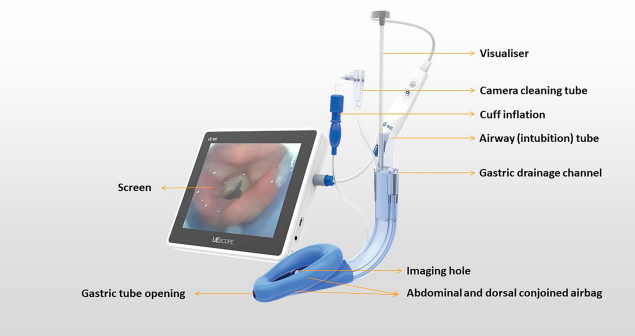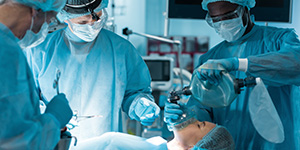Airway management is one of the most vital aspects of healthcare, especially in the fields of anesthesiology and emergency medicine. The need for innovative technology in the world today is crucial due to the constantly evolving landscape of healthcare practices. One of SourceMark’s core values is craftsmanship. We believe in the significance of craftsmanship in everything we do and the excellence that’s achieved through collaboration and creative thinking. SourceMark Medical’s latest innovation— the Intubating Video Laryngeal Mask Airway (VLMA) device— demonstrates our commitment to pursuing excellence. This breakthrough medical device combines vision-guided insertion with unmatched versatility, creating a new standard for airway management.
The Innovation Behind the Intubating VLMA
The Intubating Video Laryngeal Mask Airway (VLMA) is a second-generation device that integrates a laryngeal mask airway (LMA) with new video-assisted intubation technology. It allows clinicians to visualize the blind process of insertion and placement of the Supraglottic Airway Device (SAD) while ensuring optimal positioning.
For the first time ever, the intubating VLMA gives healthcare professionals the ability to visually guide the endotracheal tube directly through the device and into the trachea, all without removing the LMA.
Traditional LMA’s and Their Limits
Traditional Supraglottic airway management devices are inserted without visualization, which means the clinician inserts the mask “blindly”. Forty to sixty percent of cases start with the LMA being malpositioned due to blind insertion, so the procedure is already less-than-ideal from the beginning.1 Risks of traditional LMA usage and malpositioning include air leakage, aspiration risk, lack of continuous monitoring, and tissue damage.
The Intubating Video Laryngeal Mask Airway Device is an effective solution that addresses all the risks of traditional LMA usage. The VLMA allows clinicians to have direct visualization of the patient’s airway, ensuring proper placement and a tight seal to prevent air leaks around the mask. According to Dr. Corey Gacconnet, an esteemed anesthesiology specialist, “continuous monitoring will become the standard of care”.
In addition to safer placement, visualization reduces the need for direct laryngoscopy and intubation, which subsequently reduces a hospital’s pharmacy costs significantly. Organizations can save thousands of dollars on prescription drug costs annually due to a reduced need to fully intubate the patient.
Key Features
- Vision-Guided Technology

- Integrated high-definition camera for real-time visualization
- Touchscreen HD Display: Resolution 1920*1200
- Monitor working time is greater than 5 hours
- Enhanced Safety Mechanisms
- Minimized risk of incorrect placement with live feedback
- Reduction in trauma to the airway, reducing complications
- Supports effective ventilation with superior seal performance
- Unmatched Versatility
- Suitable tool for a wide range of cases
- Compatible with different clinical areas, from OR’s, ER’s, and EMS settings
Addressing Common Challenges in Airway Management
There are numerous reasons why airway management is particularly complicated during the induction of anesthesia, as each patient’s anatomy is unique. Some patients have specific conditions that impact airway management, e.g., obesity, a large tongue, a smaller retracted jaw, congenital anomalies, intraoral trauma, edema, bleeding, infections, and tumors.
Unexpected events that compromise the airway may occur due to issues such as gastric aspiration, airway obstruction, or equipment failure. Furthermore, managing the airway in the extreme-of-age patients can present additional challenges due to differences in anatomy, physiology, and pathology.
However, poor or no visibility of the oropharynx and larynx is often related to suboptimal insertion and positioning of the airway tool, with consequences such as esophageal intubation (intubation is inadvertently directed into the esophagus instead of the trachea) or malfunctioning of a supraglottic airway device (SAD).
Primary Benefits for Healthcare Professionals
- Seeing is Believing: Maximized Patient Care Efforts
- The visualized insertion process allows accurate placement and therefore avoids air leakage and improves ventilation.
- Monitors the glottis for any case of gastric reflux to reduce aspiration
- Promotes Safe and Smooth Recovery
- Video-assisted guided extubation in post-operative monitoring of airway status contributes to smoother awakening from anesthesia.
- Broader Applications
- Incredibly valuable device for anesthesiologists, emergency care providers, and critical care teams.
- Streamlined Training & Usage
- The video component allows training to be done more accurately and effectively.
- Faster adoption in diverse healthcare settings thanks to user-friendly features.
Who Will Benefit the Most?
- Hospitals and Surgery Centers
- These facilities will benefit from the device’s unique ability to provide greater precision.
- Reduces the need for direct laryngoscopy and intubation, which subsequently reduces a hospital’s pharmacy costs significantly. Organizations can save thousands of dollars on prescription drug costs annually due to a reduced need to fully intubate the patient.
- Emergency Teams
- EMS teams can use the VLMA to achieve higher success rates in intubation while under suboptimal conditions such as poor lighting, irregular surfaces, bumpy roads, and lack of time.
- Patients
- Patients stand to benefit the most through safer procedures, reduced trauma, and better outcomes.
Modernizing Airway Management
The launch of the Intubating Video Laryngeal Mask Airway device starts a new era in airway management. Its thoughtfully designed features and focus on strengthening patient care make it an essential resource for hospitals and healthcare providers committed to excellence.
Get Started Now
Discover more about how the Intubating VLMA can benefit your organization. Contact us to learn more and explore how this device can make a profound impact within your healthcare facility. Together, we can achieve greater precision, improved patient outcomes, and a brighter future for airway management.
1 J. Clin. Med. 2023, 12(16), 5197; https://doi.org/10.3390/jcm12165197









